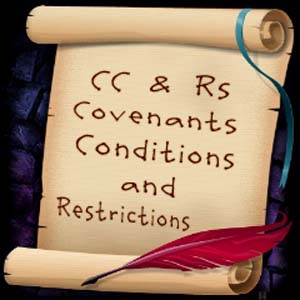 In the DFW Metroplex it is very difficult to find a newer home that is not part of a HOA and ALL HOA’s have CC&R’s that govern what you can and can not do to your home and property.
In the DFW Metroplex it is very difficult to find a newer home that is not part of a HOA and ALL HOA’s have CC&R’s that govern what you can and can not do to your home and property.
If you’re saying “HOA’s” and “CC&R’s” – What is My Realtor Talking About? Then read on…
What are HOAs and CC&Rs?
The acronyms “HOA” and “CC&Rs,” although they are used daily by real estate agents, may be unfamiliar to the average person. Let’s break down these acronyms and get you up to speed on what home buyers should know.
HOA
 HOA stands for homeowner association – a nonprofit organization that is funded by all of the association’s members and overseen by an elected board of directors. In some states, HOAs must be registered with the department of real estate or another state regulatory agency.
HOA stands for homeowner association – a nonprofit organization that is funded by all of the association’s members and overseen by an elected board of directors. In some states, HOAs must be registered with the department of real estate or another state regulatory agency.
Most of the country’s HOAs are run by volunteers from within the community, with the remainder being run by management companies.
The primary purpose of the HOA is to enforce the policies, procedures, regulations and restrictions agreed to by the members, with the intention of maintaining property values. Financial support for the HOA comes from each homeowner in the form of monthly, quarterly, biannual or annual dues and occasional assessments.
So, how does one become a member of an HOA? If you purchase a home in a managed community, you don’t have a choice about whether to become a member. It is required and automatic. For this reason, when considering the purchase of a home governed by an HOA, reading the HOA documents before you agree to purchase the home is very important.
CC&Rs
 CC&R stands for covenants, conditions and restrictions – the governing documents for the operation of the HOA. These are the rules that homeowners, tenants and guests are obligated to follow.
CC&R stands for covenants, conditions and restrictions – the governing documents for the operation of the HOA. These are the rules that homeowners, tenants and guests are obligated to follow.
Want to paint your house psychedelic pink? Check the CC&Rs first. From the number of pets allowed to parking restrictions, the CC&Rs are the laws of the community. Failure to abide by them could mean a hefty fine for the homeowner. Unpaid fines can lead to foreclosure proceedings and the loss of the home to the HOA.
Here are just a few items commonly regulated by CC&Rs, according to the authors of Nolo’s Essential Guide to Buying Your First Home:
- Noise.
- Landscaping.
- Roofing material.
- Fences.
- Exterior paint color.
- Outdoor play equipment such as swing sets and basketball hoops.
- Garages and outbuildings.
- Mailboxes.
- Window coverings.
- Holiday decorations.
- Clotheslines.
- Garbage and recycling containers.
- Pets (size, breed restrictions, etc.).
- Parking.
- Home businesses.
Purchasing a Home in an HOA-Governed Community
 Immediately after your offer is accepted on a home governed by an HOA, your agent will go to work to obtain what is typically referred to as the “HOA docs.” This is a large package that contains everything you need to know about the HOA and about life in the community.
Immediately after your offer is accepted on a home governed by an HOA, your agent will go to work to obtain what is typically referred to as the “HOA docs.” This is a large package that contains everything you need to know about the HOA and about life in the community.
Unfortunately, the HOA docs need to be ordered, then compiled by the HOA, and typically don’t reach the buyer until late in the process. By this time the buyer has usually paid for a home inspection, not to mention the HOA doc fee, which can be quite hefty.
This is a critical part of the process and requires extreme due diligence. If you don’t understand anything in the HOA documents, ask your real estate agent or attorney to explain it. Don’t close on your new home until you understand what is allowed, and what is not allowed, in the HOA documents package.
What to Look for in HOA Documents
Several documents in the HOA package require close scrutiny:
Special Assessments
A HOA will levy a special assessment when there is not enough money in the reserve fund to pay for major repairs or improvements to the community resources, such as roofs, major systems or amenities.
Check the documents carefully for the number of special assessments imposed over the life of the HOA and the amount that was imposed. Excessive assessments are a bad sign.
While you’re at it, check for mention of any major projects planned and whether the HOA reserve fund can cover them. You’ll find information about the reserve fund in the HOA’s budget. There should be a minimum of 10 percent of the annual budget amount on reserve.
Litigation
Your lender will find out about this, so you may as well check to see if there is any ongoing or pending litigation on behalf of or against the HOA. If the litigation is over construction defects, the lender won’t approve your loan until the litigation is complete.
Meeting Minutes
The HOA holds meetings and someone is responsible for keeping track of what occurs during the meetings. Look through the minutes for homeowner complaints, especially repeated complaints. This is an indication of an unresponsive HOA – another red flag. Some associations are striking homeowner comments from their minutes. If you don’t see any comments, ask your real estate agent to find out why.
No matter how much you love that adorable condo, townhouse or single family home, it’s not worth purchasing if the CC&Rs impact your lifestyle and restrict your freedom more than you are completely comfortable with. Understand that a home in a HOA comes with some restrictions on what you will be able to do to your property and consider those restrictions carefully before signing an offer to purchase that home.
If you are looking for a Northeast DFW Home please give us a call and let us meet with you to understand your unique situation. Amie and I are active in all of the Northeast DFW Metroplex and believe that “Life is Relationships and everything else is just details!” We are excited about the opportunity to meet you and walk with you through the process of finding a home and the best part of using a Realtor to buy or lease a home is you get our expertise and experience for FREE!
Check us out at FireBossRealty.com or NortheastDFWHomes.com
 FireBoss Realty would love to help you if you are looking for Homes for sale in Wylie, Homes for sale in Sachse, Homes for sale in Murphy, Homes for sale in Lucas, Homes for sale in Allen, Homes for sale in McKinney, Homes for sale in Plano or Homes for sale in Collin County.
FireBoss Realty would love to help you if you are looking for Homes for sale in Wylie, Homes for sale in Sachse, Homes for sale in Murphy, Homes for sale in Lucas, Homes for sale in Allen, Homes for sale in McKinney, Homes for sale in Plano or Homes for sale in Collin County.

